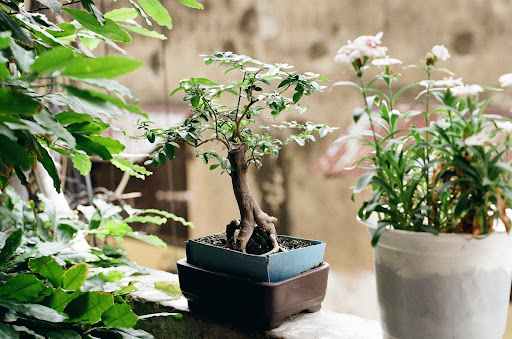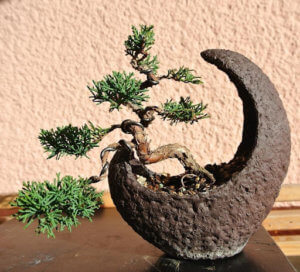
It’s easy to be mesmerised the first time you see a bonsai. Those petit trees captivate many gardeners with their magical quality of remaining tiny throughout their whole lifespan.
The literal translation of the word “bonsai” is “planted in a container” and refers to any kind of tree that is forced to remain in a miniature form by being planted in a shallow pot or tray. The art of bonsai started out thousands of years ago in Japan, where representation of bonsai trees can be found in antient art pieces. Today, bonsai have become increasingly popular around the world. With the help of YouTube tutorials, books and access to public collections, anyone can learn how to take care of a bonsai.
Read on to find out all about how to take care of an indoor bonsai tree!
Choose the right plant
Traditionally, the art of bonsai is more commonly practiced on outdoor trees that are more hardy and can withstand different climates, which is why they are known to die indoors quite often. If you want to grow your bonsai indoors then you should choose tropical trees like Ficus, Dwarf Jade or Chinese Elm. Those are some of the best choices for beginners. Those tree types require about the same amount of care as a regular houseplant so you have a better chance of keeping them healthy even if you don’t have years of experience.
Don’t go for evergreen bonsai indoors
Evergreen trees need lower temperatures to thrive, which is why indoors might be a bit too warm for them. If you put an outdoor tree indoors it won’t survive so avoid evergreens such as Juniper, Pine or Japanese Holly if you want to grow an indoor bonsai.
Shop at specialised stores
When you’re ready to purchase your first bonsai, it’s best to visit a specialised plant nursery or shop. That way you can rest assured that the tree you’re buying would’ve been taken good care of. As well as that the staff in specialised stores are knowledgeable on the topic so they can help you with any questions you might have and even give you some extra tips on how to keep your new bonsai healthy.
Find a suitable place for your plant
Bonsai trees love bright, indirect sunlight but you have to be aware that many spots right next to the windows could not be suitable for your bonsai. The light coming through might be too harsh if your window is south facing, or there could also be a cold draft coming through, both of which are not good for your tree. You should also keep your bonsai away from the direct heat from radiators which are often right under windows.

Water your bonsai regularly
Just like with every other plant bonsai need to be watered regularly. Check your tree’s water needs by poking your finger about an inch into the soil. If it feels a bit dry, water your bonsai thoroughly. You want to water just as the soil is starting to dry out. How often your bonsai needs watering is individual to different tree types and also depends on the environment you keep your bonsai in. Some bonsai might need watering every day, especially during their growth season, while others every other day or even less often. It’s also recommended to mist the leaves and branches of your tree daily to get rid of dust and promote growth.
Make sure you don’t overwater
While regular watering is key for your bonsai’s health, overwatering is one of the most common indoor bonsai killers! Yellow leaves or black tips of the leaves are the first warning signs that your bonsai might be drowning. In this case you want to let the soil dry out completely before watering the plant again. If the problem appears again then the soil might not offer good enough drainage and you should consider repotting your bonsai.
Feed your plant to promote growth
Like most trees bonsai get their nutrients from the sun and soil, but because they’re confined to such small containers the soil will eventually lose its nutrients and need fertilizer to replenish them. It’s especially important to give your bonsai plant food during its growth period when it needs to send nutrients to all the newly grown leaves and branches.
Don’t go overboard with tools
Some people may suggest that you need a dozen of different cutters and tools, but if you’re just starting out, all you’ll need is a good pair of pruning scissors and tweezers to get rid of any weeds or dead leaves. As you gain experience and get more confident in shaping your bonsai you can look into upgrading your tool kit.
Take a class
If you want to gain confidence before the first extensive pruning or repotting project for your bonsai is due, then you should consider taking a bonsai class, There are many online courses that you can sign up for or alternatively you can see if your local bonsai retailer is hosting any in-person workshops for bonsai enthusiasts. There are plenty of options out there.
Have patience
It’s important to remember that above all the art of bonsai teaches patience! It takes years to learn how to shape, cut and take proper care of your bonsai, so just let it grow and don’t rush. A big part of the enjoyment of keeping bonsai trees as a hobby is watching them grow and thrive!






